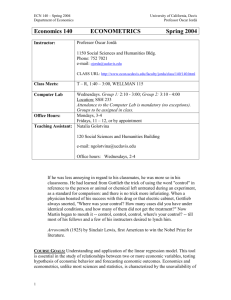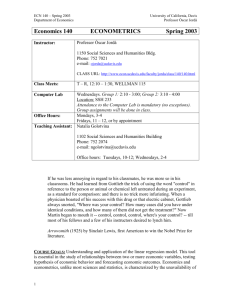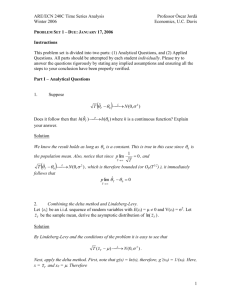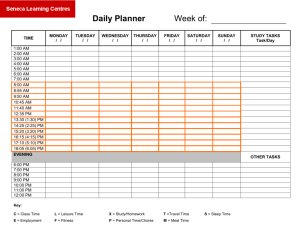Economics 140
advertisement
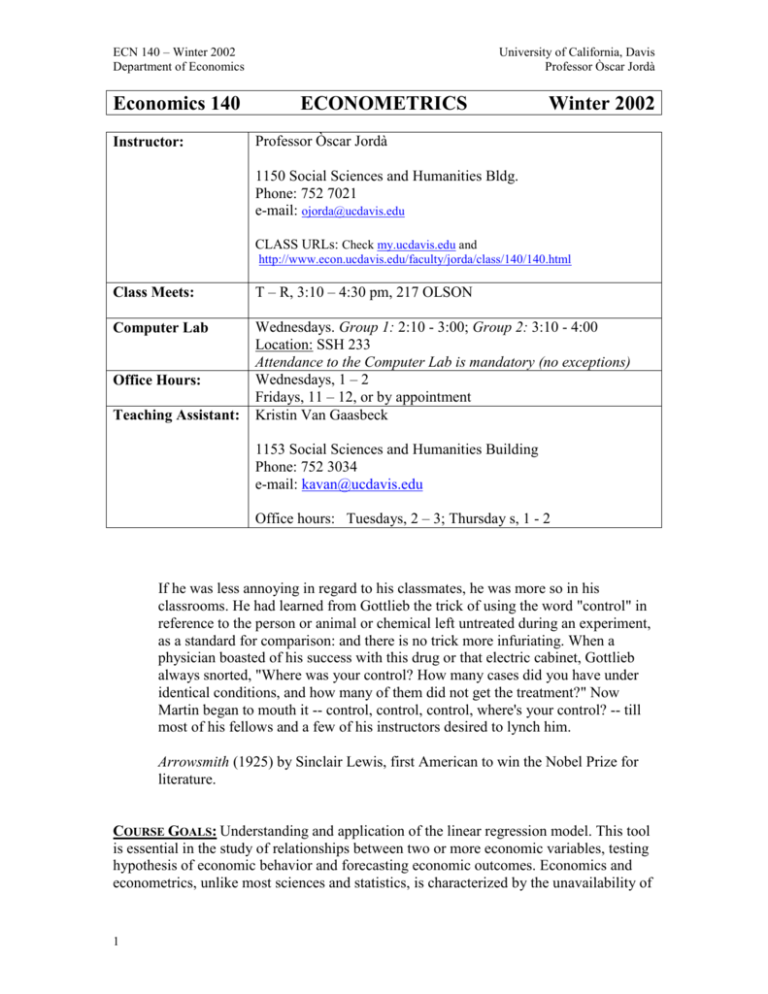
ECN 140 – Winter 2002 Department of Economics Economics 140 Instructor: University of California, Davis Professor Òscar Jordà ECONOMETRICS Winter 2002 Professor Òscar Jordà 1150 Social Sciences and Humanities Bldg. Phone: 752 7021 e-mail: ojorda@ucdavis.edu CLASS URLs: Check my.ucdavis.edu and http://www.econ.ucdavis.edu/faculty/jorda/class/140/140.html Class Meets: T – R, 3:10 – 4:30 pm, 217 OLSON Computer Lab Wednesdays. Group 1: 2:10 - 3:00; Group 2: 3:10 - 4:00 Location: SSH 233 Attendance to the Computer Lab is mandatory (no exceptions) Wednesdays, 1 – 2 Fridays, 11 – 12, or by appointment Kristin Van Gaasbeck Office Hours: Teaching Assistant: 1153 Social Sciences and Humanities Building Phone: 752 3034 e-mail: kavan@ucdavis.edu Office hours: Tuesdays, 2 – 3; Thursday s, 1 - 2 If he was less annoying in regard to his classmates, he was more so in his classrooms. He had learned from Gottlieb the trick of using the word "control" in reference to the person or animal or chemical left untreated during an experiment, as a standard for comparison: and there is no trick more infuriating. When a physician boasted of his success with this drug or that electric cabinet, Gottlieb always snorted, "Where was your control? How many cases did you have under identical conditions, and how many of them did not get the treatment?" Now Martin began to mouth it -- control, control, control, where's your control? -- till most of his fellows and a few of his instructors desired to lynch him. Arrowsmith (1925) by Sinclair Lewis, first American to win the Nobel Prize for literature. COURSE GOALS: Understanding and application of the linear regression model. This tool is essential in the study of relationships between two or more economic variables, testing hypothesis of economic behavior and forecasting economic outcomes. Economics and econometrics, unlike most sciences and statistics, is characterized by the unavailability of 1 ECN 140 – Winter 2002 Department of Economics University of California, Davis Professor Òscar Jordà controlled environments and repeated experimentation. Consequently, it is that much trickier to discover or test causal relationships, to measure the effects of a particular economic policy or an economic control on economic states, and other similar thought experiments. Econometrics not only provides adequate statistical methods but also clever solutions to overcome many of these obstacles. PRE-REQUISITES: Statistics 13, Math 16A-16B, Econ 100 or 104, and 101 or 105. 102 highly recommended. Statistics 13 is the most important. Algebra (though not matrix algebra) and some calculus are extensively used. Problem sets will require use of the computer, but no previous experience is assumed. TEXTBOOK: Hill, Carter H., William E. Griffiths and George G. Judge (2001) Undergraduate Econometrics, 2nd Edition, John Wiley and Sons: New York. COMPUTER SOFTWARE: EViews. You can purchase the student version at the bookstore. This is NOT required, however. The computer sessions should provide you with enough time to complete the assignments. It is to your benefit (convenience, personal growth, consulting, …) to own your copy. ADDITIONAL RESOURCES: Check the class web page for additional materials such as formula sheet, a brief overview of EViews, interesting web sites for econometricians, etc. COMPLEMENTARY LITERATURE: (these books are on reserve at the library) R. J. Larsen and M. L. Marx, An Introduction to Mathematical Statistics and its Applications, Prentice Hall. This is an excellent text to review in more depth the statistical concepts presented in class and beyond. This is an undergraduate text, therefore very accessible. A. Spanos, Statistical Foundations of Econometric Modelling, Cambridge. This is a more advanced book than Larsen and Marx. However, it contains proofs and topics in great detail. C. Hill, W. Griffiths, and G. Judge, Undergraduate Econometrics, John Wiley. Very concise and to the point. R. Ramanathan, Introductory Econometrics with Applications, Dryden. It is very well written and gives a great number of useful examples. A little hard to navigate. W. Greene, Econometric Analysis, Prentice Hall. This is an advanced text. In addition to the topics we will cover in class, it contains a number of additional topics that give you a flavor of the discipline. A good resource book. COMPUTER ASSIGNMENTS: Homework problems that require the computer will use the software program EViews (already installed in the computer lab). I will teach a lab session illustrating how the assignments can be completed. Check the lab schedule to 2 ECN 140 – Winter 2002 Department of Economics University of California, Davis Professor Òscar Jordà plan times when you can complete your assignment. The day before assignments are due, the T.A. will be available during lab hours to address any lingering questions. COURSE GRADING: Homework (4/5) Midterms (2) 30% 35% Final (Comprehensive) 35% Tuesday, February 5 Thursday, February 28 Thursday, March 21, 1:30-3:30 Homework must be handed on time. There is no credit for late homework. Please contact the T.A. at your convenience if you need special arrangements and rescheduling for midterms and final. All requests must be made by January 17. Make-up exams are not permitted. Consult the web schedule for more details on homework due dates. REGRADE POLICY: I do not engage in grade bargaining. I try to apply the same standard to everyone, which makes special considerations unfair to your peers. If you feel a question was unfairly graded or there was a mistake, please submit it in writing to your T.A. no later than a week after the exam. This allows your T.A. to go over the exam carefully and give your queries due consideration. CALENDAR January Wednesday, 9: LAB Instruction Wednesday, 16: LAB Assistance Thursday, 17: Assignment 1 Due Monday, 21: Holiday Wednesday, 23: LAB Instruction Wednesday, 30: LAB Assistance Thursday, 31: Assignment 2 Due 3 ECN 140 – Winter 2002 Department of Economics February Tuesday, 5: Midterm 1 Wednesday, 6: LAB Instruction Wednesday, 13: LAB Assistance Thursday, 14: Assignment 3 Due Monday, 18: Holiday Wednesday, 20: LAB Instruction Wednesday, 27: LAB Assistance Thursday, 28: Assignment 4 Due and Midterm 2. March Wednesday, 6: LAB Instruction Wednesday, 13: LAB Assistance Thursday, 14: Assignment 5 Due – Last day of classes Thursday, 21: FINAL EXAM. 1:30 – 3:30 COURSE OUTLINE: I. STATISTICAL TOOLS FOR ECONOMETRICIANS 1. RANDOM VARIABLES i. DISCRETE ii. CONTINUOUS 2. UNIVARIATE PROBABILITY DENSITY FUNCTIONS i. DISCRETE PDF AND CDF ii. CONTINUOUS PDF AND CDF 3. MULTIVARIATE PROBABILITY DENSITY FUNCTIONS i. THE JOINT DISTRIBUTION ii. THE MARGINAL DISTRIBUTION iii. THE CONDITIONAL DISTRIBUTION iv. INDEPENDENCE 4 University of California, Davis Professor Òscar Jordà ECN 140 – Winter 2002 Department of Economics University of California, Davis Professor Òscar Jordà 4. MOMENTS OF PROBABILITY DISTRIBUTIONS i. UNIVARIATE a. POPULATION MEAN, MEDIAN, AND MODE b. POPULATION VARIANCE ii. MULTIVARIATE a. CONDITIONAL MEAN b. COVARIANCE c. CORRELATION 5. COMMON DISTRIBUTION FUNCTIONS i. THE NORMAL AND THE STANDARD NORMAL ii. THE 2 DISTRIBUTION iii. THE T-DISTRIBUTION iv. THE F-DISTRIBUTION 6. POPULATIONS, SAMPLES, STATISTICS AND ESTIMATION i. POPULATIONS VERSUS SAMPLES ii. MOMENTS VERSUS SAMPLE STATISTICS iii. PROPERTIES OF ESTIMATORS a. UNBIASEDNESS b. EFFICIENCY 7. HYPOTHESIS TESTING i. ELEMENTS OF A TEST ii. TESTING THE MEAN II. TWO VARIABLE REGRESSION MODEL 1. MODEL ASSUMPTIONS i. LINEARITY ii. HOMOSCEDASTICITY iii. INDEPENDENCE iv. REGRESSOR VARIATION v. NORMALITY vi. RESIDUAL INDEPENDENCE 2. ESTIMATION 5 ECN 140 – Winter 2002 Department of Economics University of California, Davis Professor Òscar Jordà i. METHOD OF MOMENTS ii. LEAST SQUARES 3. PROPERTIES OF OLS ESTIMATORS i. UNBIASEDNESS ii. EFFICIENCY iii. GAUSS-MARKOV THEOREM 4. HYPOTHESIS TESTING i. CONFIDENCE INTERVALS ii. ONE-TAIL TESTS iii. TWO-TAIL TESTS 5. GOODNESS OF FIT - THE R2 6. PREDICTION 7. VARIABLE TRANSFORMATIONS i. CHANGES OF SCALE ii. CHANGES OF ORIGIN iii. FUNCTIONAL FORMS III. MULTIPLE LINEAR REGRESSION MODEL 1. THE MODEL AND ADDITIONAL ASSUMPTIONS 2. ESTIMATION 3. HYPOTHESIS TESTING i. JOINT HYPOTHESIS TESTING a. SIGNIFICANCE OF SUBSETS OF REGRESSORS b. OVERALL SIGNIFICANCE TESTS c. TESTS OF LINEAR COMBINATIONS OF PARAMETERS 4. GOODNESS OF FIT i. THE R2 AND THE ADJUSTED R2 ii. MODEL SELECTION 5. PREDICTION i. POINT FORECASTS ii. CONDITIONAL MEAN FORECASTS 6. SPECIFICATION ERRORS 6 ECN 140 – Winter 2002 Department of Economics University of California, Davis Professor Òscar Jordà i. OMITTED VARIABLES ii. IRRELEVANT VARIABLES iii. MULTICOLLINEARITY IV. EXTENSIONS 1. DUMMY VARIABLES i. MULTIPLE DUMMY VARIABLES IN REGRESSION ii. INTERACTIVE DUMMY VARIABLES 2. HETEROSCEDASTICITY i. DETECTION ii. SOLUTIONS 3. THE MULTIPLE REGRESSION MODEL IN MATRIX NOTATION 4. MAXIMUM LIKELIHOOD ESTIMATION 7
